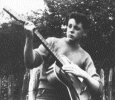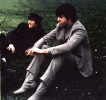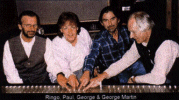Paul
BUY
PAUL SOLO CDS

 James
Paul McCartney was born on June 18, 1942 at Walton Road Hospital in
Rice Lane, Liverpool. He was the first son of James and Mary. His
brother, Peter, was born eighteen months later. His mother, Mary,
was a midwife and his father, James, was a cotton salesman and a member
of a Jazz band. In 1955, when Paul was just 14, his mother died of
breast cancer.
James
Paul McCartney was born on June 18, 1942 at Walton Road Hospital in
Rice Lane, Liverpool. He was the first son of James and Mary. His
brother, Peter, was born eighteen months later. His mother, Mary,
was a midwife and his father, James, was a cotton salesman and a member
of a Jazz band. In 1955, when Paul was just 14, his mother died of
breast cancer.
As a child, Paul had little interest in music. Both
he and his brother were sent to piano lessons but they didn't last long. He taught himself how to play the trumpet
which was a present from his uncle. His father's musical talent was
probably passed onto Paul. Of all the Beatles, Paul's family was the
only one with a musical background. Paul did very well in school,
in 1957 he passed his 11-Plus examination and entered the Liverpool
Institute. There, he met a younger student by the name of George Harrison.
but they didn't last long. He taught himself how to play the trumpet
which was a present from his uncle. His father's musical talent was
probably passed onto Paul. Of all the Beatles, Paul's family was the
only one with a musical background. Paul did very well in school,
in 1957 he passed his 11-Plus examination and entered the Liverpool
Institute. There, he met a younger student by the name of George Harrison.
 Paul
was introduced to John by a mutuel friend, Ivan Vaughan. He invited
Paul to see The Quarrymen play at the Wooten Parish Church Fete at
St. Peter's Church. Paul didn't want to go but when he was told that
it would be a great place to meet girls, his opinion changed. When
Paul arrived, they were already on stage and John was singing his
version of the Dell Vikings' "Come Go With Me" but since he had only
heard it on the radio, his lyrics were hopelessly wrong. Having been
introduced, Paul played Eddie Cochran's "Twenty Flight Rock" with
correct lyrics and chord changes. They were astonished and Paul was
asked to join the band soon afterwards.
Paul
was introduced to John by a mutuel friend, Ivan Vaughan. He invited
Paul to see The Quarrymen play at the Wooten Parish Church Fete at
St. Peter's Church. Paul didn't want to go but when he was told that
it would be a great place to meet girls, his opinion changed. When
Paul arrived, they were already on stage and John was singing his
version of the Dell Vikings' "Come Go With Me" but since he had only
heard it on the radio, his lyrics were hopelessly wrong. Having been
introduced, Paul played Eddie Cochran's "Twenty Flight Rock" with
correct lyrics and chord changes. They were astonished and Paul was
asked to join the band soon afterwards.
After Paul's first performance with The Quarrymen, he
played John some songs that he had  written
himself. John was impressed and later began writing some songs of
his own. They began advising and motivating each other on their songs
before deciding to collaborate and subsequently became the greatest
writing partnership of all time. Having established themselves as
songwriters, Paul and John would often write independently of one
another. An early agreement between Paul and John ensured that all
Beatles songs that either wrote would bear the trademark of "Lennon
& McCartney".
written
himself. John was impressed and later began writing some songs of
his own. They began advising and motivating each other on their songs
before deciding to collaborate and subsequently became the greatest
writing partnership of all time. Having established themselves as
songwriters, Paul and John would often write independently of one
another. An early agreement between Paul and John ensured that all
Beatles songs that either wrote would bear the trademark of "Lennon
& McCartney".
Paul met Jane Asher at a pop concert at Albert Hall.
The Radio Times asked her to go to the concert to give her impression
of The Beatles. After the concert she joined them in their hotel  for
a drink. He wanted her to give up acting and spend all of her time
with him but she refused. This led to a number of arguments but Paul
was still obsessed with her. It was for Jane Asher that he wrote "I'm
Looking Through You" and "And I Love Her". On Christmas Day 1967,
Paul proposed to her and she accepted.
for
a drink. He wanted her to give up acting and spend all of her time
with him but she refused. This led to a number of arguments but Paul
was still obsessed with her. It was for Jane Asher that he wrote "I'm
Looking Through You" and "And I Love Her". On Christmas Day 1967,
Paul proposed to her and she accepted.
This engagement lasted almost one year. In December
1968, Paul left for a holiday in  Portugal.
Here he met an American divorcee named Linda Eastman. Paul's relationship
with Jane Asher ended. Beatle fans and the world media were stunned
by the ending of this five year romance. Many young girls had idolised
Jane because of her relationship with Paul and the arrival of Linda
was not taken to kindly by many Beatles fans. In the end, however,
she became Paul McCartney's wife in March 1969.Paul adopted Heather,
Linda's daughter, and the couple had three children of their own,
Mary, Stella and James.
Portugal.
Here he met an American divorcee named Linda Eastman. Paul's relationship
with Jane Asher ended. Beatle fans and the world media were stunned
by the ending of this five year romance. Many young girls had idolised
Jane because of her relationship with Paul and the arrival of Linda
was not taken to kindly by many Beatles fans. In the end, however,
she became Paul McCartney's wife in March 1969.Paul adopted Heather,
Linda's daughter, and the couple had three children of their own,
Mary, Stella and James.
During Paul's career as a Beatle, a rumour of his death
was spread and this fascinated  many
fans. Paul once said, "I am alive and well and concerned about rumours
of my death, but if I were dead, I would be the
many
fans. Paul once said, "I am alive and well and concerned about rumours
of my death, but if I were dead, I would be the  last
to know." There are many "clues" to his death throughout The Beatles'
career. Apparantly, Paul's head looks fake on the cover of Rubber
Soul. The cover of Revolver is the next "clue". Paul's head is the
only one turned sideways and the little picture of him appears to
be screaming. The coincidences really began to gather when the band
suddenly stopped touring after this album was released. The yellow
flowers on the cover of Sgt. Peppers seem
last
to know." There are many "clues" to his death throughout The Beatles'
career. Apparantly, Paul's head looks fake on the cover of Rubber
Soul. The cover of Revolver is the next "clue". Paul's head is the
only one turned sideways and the little picture of him appears to
be screaming. The coincidences really began to gather when the band
suddenly stopped touring after this album was released. The yellow
flowers on the cover of Sgt. Peppers seem  to
spell out "Paul". On the cover of Magical Mystery Tour, we see the
band in costume. Is this so that we don't recognise the fake Paul?
At the end of Strawberry Fields, John mutters something. It sounds
like "I buried Paul". John mutters again on I'm So Tired. If you play
this backwards, it sounds like "Paul is dead, miss him,
to
spell out "Paul". On the cover of Magical Mystery Tour, we see the
band in costume. Is this so that we don't recognise the fake Paul?
At the end of Strawberry Fields, John mutters something. It sounds
like "I buried Paul". John mutters again on I'm So Tired. If you play
this backwards, it sounds like "Paul is dead, miss him,  miss
him." When Revolution No. 9 is played backwards, it sounds like "Turn
me on dead man". Then there is the "Abbey Road" cover. Here we see
Paul walking barefoot, out of stride with everybody else and there
is a hearse in the background. Thankfully this was all a rumour that
obsessed fans read into fairly well because I have uncovered many
more less obvious clues that were simply found because so many people
had been analysing The Beatles in search of anything that might remotely
suggest Paul's death. If you are interested in this rumour, click
here for more information.
miss
him." When Revolution No. 9 is played backwards, it sounds like "Turn
me on dead man". Then there is the "Abbey Road" cover. Here we see
Paul walking barefoot, out of stride with everybody else and there
is a hearse in the background. Thankfully this was all a rumour that
obsessed fans read into fairly well because I have uncovered many
more less obvious clues that were simply found because so many people
had been analysing The Beatles in search of anything that might remotely
suggest Paul's death. If you are interested in this rumour, click
here for more information.
 When
The Beatles disbanded, many believe that it was Linda behind the immediate
formation of Paul's new band, Wings. Several albums were produced
by this band in which Linda played the keyboard and sang. Although
many albums were critically acclaimed, they failed to recapture the
magic of The Beatles.
When
The Beatles disbanded, many believe that it was Linda behind the immediate
formation of Paul's new band, Wings. Several albums were produced
by this band in which Linda played the keyboard and sang. Although
many albums were critically acclaimed, they failed to recapture the
magic of The Beatles.
The popularity of the Beatles Anthology albums showed
that the world still loved The Beatles even though they were released
in the 1990s. Paul released  "Flaming
Pie" soon after the the Anthology albums. This was quickly followed
by the release of "Standing Stone", a classical music work using computer
technology to transcribe sound into musical score. April 17 1998 was
the day the Linda tragically lost her battle against breast cancer.
"Flaming
Pie" soon after the the Anthology albums. This was quickly followed
by the release of "Standing Stone", a classical music work using computer
technology to transcribe sound into musical score. April 17 1998 was
the day the Linda tragically lost her battle against breast cancer.





 James
Paul McCartney was born on June 18, 1942 at Walton Road Hospital in
Rice Lane, Liverpool. He was the first son of James and Mary. His
brother, Peter, was born eighteen months later. His mother, Mary,
was a midwife and his father, James, was a cotton salesman and a member
of a Jazz band. In 1955, when Paul was just 14, his mother died of
breast cancer.
James
Paul McCartney was born on June 18, 1942 at Walton Road Hospital in
Rice Lane, Liverpool. He was the first son of James and Mary. His
brother, Peter, was born eighteen months later. His mother, Mary,
was a midwife and his father, James, was a cotton salesman and a member
of a Jazz band. In 1955, when Paul was just 14, his mother died of
breast cancer.  but they didn't last long. He taught himself how to play the trumpet
which was a present from his uncle. His father's musical talent was
probably passed onto Paul. Of all the Beatles, Paul's family was the
only one with a musical background. Paul did very well in school,
in 1957 he passed his 11-Plus examination and entered the Liverpool
Institute. There, he met a younger student by the name of George Harrison.
but they didn't last long. He taught himself how to play the trumpet
which was a present from his uncle. His father's musical talent was
probably passed onto Paul. Of all the Beatles, Paul's family was the
only one with a musical background. Paul did very well in school,
in 1957 he passed his 11-Plus examination and entered the Liverpool
Institute. There, he met a younger student by the name of George Harrison.
 Paul
was introduced to John by a mutuel friend, Ivan Vaughan. He invited
Paul to see The Quarrymen play at the Wooten Parish Church Fete at
St. Peter's Church. Paul didn't want to go but when he was told that
it would be a great place to meet girls, his opinion changed. When
Paul arrived, they were already on stage and John was singing his
version of the Dell Vikings' "Come Go With Me" but since he had only
heard it on the radio, his lyrics were hopelessly wrong. Having been
introduced, Paul played Eddie Cochran's "Twenty Flight Rock" with
correct lyrics and chord changes. They were astonished and Paul was
asked to join the band soon afterwards.
Paul
was introduced to John by a mutuel friend, Ivan Vaughan. He invited
Paul to see The Quarrymen play at the Wooten Parish Church Fete at
St. Peter's Church. Paul didn't want to go but when he was told that
it would be a great place to meet girls, his opinion changed. When
Paul arrived, they were already on stage and John was singing his
version of the Dell Vikings' "Come Go With Me" but since he had only
heard it on the radio, his lyrics were hopelessly wrong. Having been
introduced, Paul played Eddie Cochran's "Twenty Flight Rock" with
correct lyrics and chord changes. They were astonished and Paul was
asked to join the band soon afterwards.  written
himself. John was impressed and later began writing some songs of
his own. They began advising and motivating each other on their songs
before deciding to collaborate and subsequently became the greatest
writing partnership of all time. Having established themselves as
songwriters, Paul and John would often write independently of one
another. An early agreement between Paul and John ensured that all
Beatles songs that either wrote would bear the trademark of "Lennon
& McCartney".
written
himself. John was impressed and later began writing some songs of
his own. They began advising and motivating each other on their songs
before deciding to collaborate and subsequently became the greatest
writing partnership of all time. Having established themselves as
songwriters, Paul and John would often write independently of one
another. An early agreement between Paul and John ensured that all
Beatles songs that either wrote would bear the trademark of "Lennon
& McCartney".  for
a drink. He wanted her to give up acting and spend all of her time
with him but she refused. This led to a number of arguments but Paul
was still obsessed with her. It was for Jane Asher that he wrote "I'm
Looking Through You" and "And I Love Her". On Christmas Day 1967,
Paul proposed to her and she accepted.
for
a drink. He wanted her to give up acting and spend all of her time
with him but she refused. This led to a number of arguments but Paul
was still obsessed with her. It was for Jane Asher that he wrote "I'm
Looking Through You" and "And I Love Her". On Christmas Day 1967,
Paul proposed to her and she accepted.  Portugal.
Here he met an American divorcee named Linda Eastman. Paul's relationship
with Jane Asher ended. Beatle fans and the world media were stunned
by the ending of this five year romance. Many young girls had idolised
Jane because of her relationship with Paul and the arrival of Linda
was not taken to kindly by many Beatles fans. In the end, however,
she became Paul McCartney's wife in March 1969.Paul adopted Heather,
Linda's daughter, and the couple had three children of their own,
Mary, Stella and James.
Portugal.
Here he met an American divorcee named Linda Eastman. Paul's relationship
with Jane Asher ended. Beatle fans and the world media were stunned
by the ending of this five year romance. Many young girls had idolised
Jane because of her relationship with Paul and the arrival of Linda
was not taken to kindly by many Beatles fans. In the end, however,
she became Paul McCartney's wife in March 1969.Paul adopted Heather,
Linda's daughter, and the couple had three children of their own,
Mary, Stella and James. 






